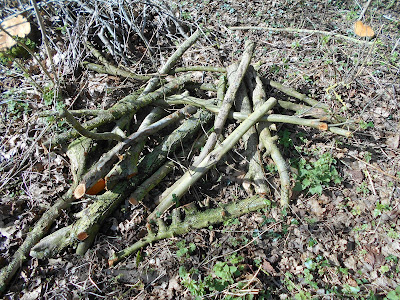At the edge of the area etween Thames Road and Leamington Way is a little strip of what was once a hedgerow. It consists of overgrown hawthorns and conceals a good deal (perhaps I should say bad deal) of plastic and paper rubbish. But there, clearly content with their lot, were half a dozen plants of Wood Anemone, Anemone nemorosa.
 |
Wood Anemone at the edge of The Grange, Daventry.
30 March, 2017
|
There can be little doubt that they had survived there from a time, over forty or so years ago, when this was open countryside. John Clare wrote:
And Anemone's weeping flowers
Dyed in winter's snow and rime
Constant to their early time
White the leaf strewn ground again
And make each wood a garden then.
... but I'll wager he wasn't thinking of this situation. Would it be immoral to sneak some seeds into Kentle Wood? To re-seed a wood is only like re-seeding a meadow, and that has beccome common practice
 |
There are six petaloid sepals here but there can be up to nine.
The Grange, Daventry. 30 March, 2017
|
There was a second surprise for only a few paces away grew a very close but alien relative, Anemone blanda. Known as the Balkan Anemone it is clearly happy in U.K. gardens and has escaped in many areas.
 |
The sepals on the Balkan Anemone are far more numerous.
The Grange, Daventry. 30 March, 2017
|
In this particular location it is likely to be a garden throw-out but hopefully it will survive to spread.
The Celandine, Ficaria verna, is a very close relative, all these plants being in the Buttercup family, Ranunculaceae. It too was growing plentifully and was an unwelcome presence in the nearby gardens too. Normally I would not have bothered to photograph it but the leaves are often interesting. Indeed, the leaf-shape is one feature which separates it from the true buttercups.
 |
Ficaria verna was common in the area. The Grange, Daventry.
30 March, 2017
|
Sometimes the leaves can be marked in a manner resembling certain cyclamens and the patterning on these particular plants was very distinctive.
 |
The distinctive leaves of the celandine are completely hairless.
|
Once home I scurried into my front garden where a clump of Cyclamen hederifolium allowed a comparative photograph.
 |
Sowbread, Cyclamen hederifolium, in our front garden at Stefen Hill,
Daventry. 30 March, 2017
|
So The Grange came up with quite a lot of interest after all and to round it off I took a picture of a Dark-edged Bee Fly, Bombylius major, a common insect to be sure but my first of the year. Often mistaken for a bee it has only two wings compared with the four of a bee.
 |
Bombylius major at The Grange, Daventry.
30 March, 2017
|
We have four species of bee-fly in Britain but for any of the three remaining species one must travel beyond Northamptonshire - as far as I know.
Tony White: diaea@yahoo.co.uk
Tony White: diaea







































